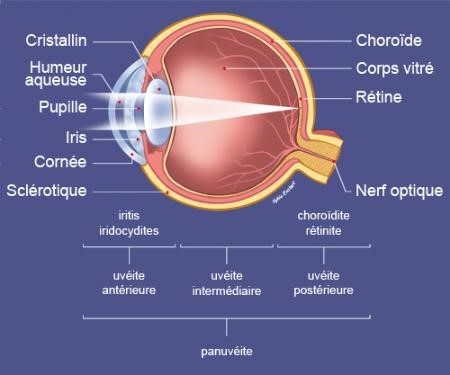Uveitis
Uveitis is an inflammation of the internal structures of the eye, which manifests itself as reduced vision and often redness and pain in the eye.
What is uveitis?
Uveitis is an inflammation of the uvea, the portion of the eye that includes the iris, ciliary body and choroid. Depending on the structures affected, 3 types of uveitis are described:
- Anterior uveitis, when the structures in front of the eye (iris) are affected. The eye is red and painful, with decreased vision.
- Intermediate uveitis involves the intermediate structures (vitreous). It is usually painless, but is accompanied by decreased visual acuity and the perception of small black spots.
- Posterior uveitis involves the structures behind the eye (choroid, retina). It is also expressed by a decrease in visual acuity, the sensation of seeing blurred, associated with the perception of more or less mobile spots in the visual field.
There is also a form called panuveitis, which combines all three types of damage.

3 types of uveitis exist. They can be associated. You should follow your ophthalmologist’s prescription to avoid significant loss of vision.
What causes uveitis?
There are many causes and they vary in severity. The work-up when looking for the cause, when it is not obvious, can be important, and it is quite common for the cause to be missed. Some of these causes are commonplace, others exceptional.
Local causes: foreign body, ocular wound, following surgery, ocular tumour, old retinal detachment…
Loco-regional causes: ENT or dental infection.
General infectious causes: tuberculosis, candidiasis, histoplasmosis, herpes, shingles…
Rheumatic causes: ankylosing spondylitis, rheumatoid arthritis, juvenile arthritis…
General causes: diabetes, sarcoidosis, meningitis, lymphoma…
How does uveitis develop?
When treated, uveitis generally heals well and without after-effects. However, recurrences are frequent and their repetition will favour the appearance of complications, such as the development of a cataract or glaucoma, retinal detachment, blood circulation anomalies in the optic nerve, etc.
The main risk of evolution of untreated uveitis is therefore the more or less important loss of vision.
What treatment should I follow?
The treatment will depend on the cause and location of the uveitis.
Generally, treatment is based on the use of corticosteroids locally or orally, more rarely by injection into the eye or around the eye. Pupil-dilating eye drops are usually combined with this to prevent adhesions from forming in the eye. For more severe cases, treatments called immunosuppressants may be necessary. These are more difficult to start and monitor and may require a short stay in hospital.
If uveitis is the consequence of a particular disease (infection, systemic disease, etc.), treatment of this condition is also naturally required.
CONTACT
You want to make an appointment? You can either call one of the 5 sites via the button below, or make an appointment directly online in the Contact section, or send me a message in the Contact section
The ophthalmology secretaries and Dr. Qin’s team are available to answer all your questions and requests for information in order to make the best choice. I will be pleased to welcome you at one of the 5 sites.

